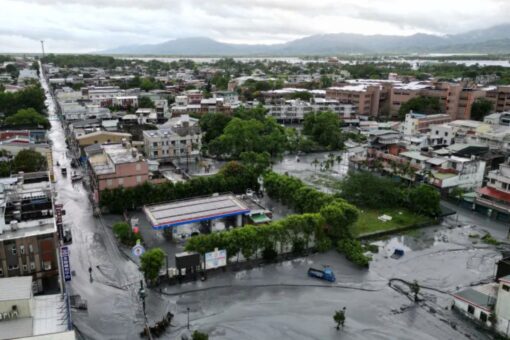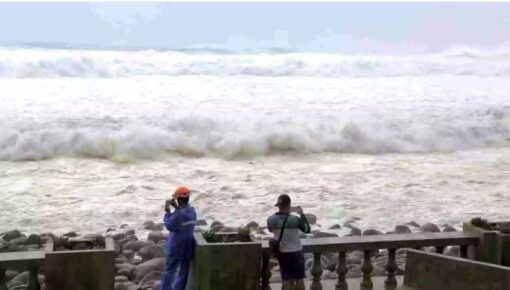Super Typhoon Ragasa has carved a devastating path across East Asia, leaving at least 14 people dead in Taiwan, crippling transportation in Hong Kong, and prompting mass evacuations in southern China.
The storm, one of the strongest in recent memory, has unleashed torrential rains, deadly floods, and destructive winds that continue to disrupt millions of lives as emergency crews race against time to locate more than 120 people still missing.
In Taiwan’s Hualien County, a rural region that bore the brunt of Ragasa’s fury, a barrier lake along Matai’an Creek burst its banks after days of relentless rainfall.
Walls of water swept through Guangfu Township, dragging cars, swallowing bridges, and leaving entire neighborhoods buried in mud. Authorities confirmed that most of those killed were elderly residents who could not escape the surging torrents in time.
Taiwan’s Central News Agency reported that the natural dam, formed by earlier landslides, overflowed Tuesday morning before collapsing under pressure by late afternoon, unleashing a catastrophic surge that caught communities off guard.
Heart-wrenching images showed people stranded on rooftops, waving desperately for rescue as floodwaters surged around them. Videos broadcast by Taiwanese outlets captured the sheer force of the deluge, with currents strong enough to snap concrete structures in half.

Rescue teams, many of them volunteers, spent the night pulling survivors from rooftops and searching for the missing under layers of silt and debris. As of Wednesday, 34 people were confirmed injured, but officials warned the toll could rise sharply in the coming days.
President William Lai Ching-te called the situation “one of Taiwan’s worst flood disasters in decades” and urged calm as the government mobilized the military and multiple ministries for relief efforts. In a late-night statement posted to Facebook, Lai emphasized the need for continued vigilance.
“Every unit must prioritize human life and ensure the safety of first responders,” he wrote, acknowledging the risks facing rescue workers navigating dangerous waters and unstable terrain. Schools and offices across affected counties remained closed, while emergency shelters filled with thousands of displaced residents seeking safety.
The storm’s impact was not confined to Taiwan. As Ragasa moved westward, it swept across the South China Sea, pounding Hong Kong with some of the most powerful winds recorded in years.
The Hong Kong Observatory issued its highest “T10” warning early Wednesday, warning residents to stay indoors as typhoon-force gusts rattled skyscrapers and whipped waves higher than lampposts onto the city’s promenades.
Streets in low-lying districts were transformed into rivers, taxis stalled in waist-deep water, and fallen trees blocked major roads.
Local officials said Ragasa’s winds reached sustained speeds between 112 and 153 kilometers per hour, with gusts exceeding 184 kilometers per hour.
The force was enough to shatter glass panels on office towers and send scaffolding crashing down, while residents described windows vibrating violently under pressure.
Ferry services and rail links were suspended, schools were closed, and more than 700 flights were grounded at Hong Kong International Airport. For hours, the city’s world-famous skyline was cloaked in sheets of rain, illuminated only by flashes of lightning.
Authorities also warned of a heightened risk of landslides across Hong Kong’s steep hillsides, already saturated by days of heavy rain. “The public should remain on high alert.
The weather will remain adverse with frequent heavy squalls and thunderstorms. Seas will be phenomenal with swells,” the Observatory cautioned in its morning advisory.
Despite assurances that Ragasa was beginning to move away from the city by late morning, officials stressed that dangerous conditions would linger well into the night.
China, too, braced for the storm’s arrival. In Guangdong province, authorities relocated more than one million people from vulnerable coastal zones, according to state media. Shelters were set up in schools and sports centers, while fishing fleets were ordered back to port.
In Shenzhen, supermarkets were packed as residents stocked up on essentials, fearing days of disruptions. Ragasa’s projected path suggested that while the storm was weakening slightly, it would still bring destructive winds and torrential downpours to southern China, threatening flash floods and river overflows.
The scale of Ragasa’s destruction has once again drawn attention to the vulnerability of densely populated Asian coastlines to extreme weather.
In just three days, the typhoon tore through the Philippines, Taiwan, Hong Kong, and southern China, displacing hundreds of thousands and cutting off power to entire provinces.
Some meteorologists compared Ragasa’s intensity to Super Typhoon Haiyan, which devastated the Philippines in 2013, though Ragasa’s broader geographic reach has affected a wider swath of the region.
Taiwan’s disaster response agencies reported that parts of Hualien County received more than 700 millimeters of rain, while southern and eastern towns endured 500 to 600 millimeters, totals equivalent to several months’ rainfall compressed into a few days.
Roads were washed away, electricity lines snapped, and water supply networks were crippled. Emergency teams deployed inflatable rafts to reach villages otherwise cut off from the outside world. Helicopters circled overhead, scanning for signs of life in isolated valleys.
The storm’s disruption extended to regional air travel and trade. Taiwan’s Taoyuan International Airport canceled more than 160 flights, mostly short-haul routes to Hong Kong and Macau, while cargo operations ground to a halt.

In Hong Kong, the closure of one of Asia’s busiest airports reverberated across international supply chains, affecting shipments of electronics, textiles, and fresh food. Business leaders warned that if Ragasa’s aftereffects lingered, the economic impact could run into billions of dollars.
International leaders expressed condolences and pledged support. Messages of solidarity poured in from Japan, South Korea, and the United States, with offers of technical assistance and disaster relief.
The United Nations Office for Disaster Risk Reduction said it was monitoring the situation closely and underscored the importance of climate resilience as typhoons grow stronger in frequency and intensity.
Scientists have repeatedly linked such superstorms to warming oceans fueled by climate change, warning that disasters like Ragasa may become the new norm in the decades ahead.
For survivors, however, the concern was more immediate: how to rebuild shattered homes and livelihoods. In Hualien, residents returning to their neighborhoods found their possessions buried under meters of mud.
Farmers surveyed fields stripped bare by floodwaters, while small businesses counted the cost of ruined stock. Volunteers distributed food, water, and blankets, but frustration mounted as shortages loomed. With more than 120 people still missing, families clung to hope that loved ones might yet be found alive.
As Taiwan begins its cleanup and Hong Kong cautiously emerges from lockdown, Ragasa’s legacy is far from over. Floodwaters continue to surge downstream into southern China, where swollen rivers threaten to overflow in the coming days.
Emergency sirens echoed across Guangdong as residents braced for the storm’s final strike. The resilience of communities is once again being tested, but the scars of this disaster will endure long after the skies clear.
Super Typhoon Ragasa has left a region on edge, its power a sobering reminder of nature’s force and the fragility of human infrastructure.
For those who lost family, homes, and livelihoods, recovery will take months, if not years. And for governments across Asia, the storm has underscored the urgent need to strengthen defenses against a climate reality in which superstorms like Ragasa are no longer rare, but recurring threats.


